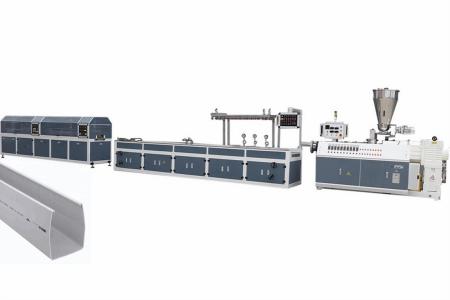Golden Far East Machinery Co.,Ltd.
Manufacturing Plastic Machinery Factory
PVC (Polyvinyl Chloride) profiles are widely used in construction and
manufacturing industries due to their versatility, durability, and
cost-effectiveness. However, during production, these profiles can sometimes
bend and deform, leading to quality issues that can affect their performance and
aesthetic appeal. Understanding the reasons behind this bending and deformation
is crucial for manufacturers to improve their production processes and ensure
consistent product quality. This article explores the various factors that
contribute to the bending and deformation of PVC profiles during production.

One of the primary reasons for PVC profile deformation during production is improper temperature control during the extrusion process. Extrusion is a process where PVC material is melted and forced through a die to form a specific profile shape. The temperature must be carefully controlled throughout the process to ensure that the material flows evenly and consistently.
Overheating: If the temperature is too high, the PVC material can become overly fluid, leading to uneven flow and resulting in a profile that bends or deforms as it cools.
Underheating: On the other hand, if the temperature is too low, the PVC may not melt properly, leading to uneven extrusion and weak spots in the profile that can cause bending or warping.
The cooling process is another critical factor that can influence the straightness of PVC profiles. After the PVC is extruded, it needs to be cooled rapidly to set its shape. However, uneven cooling can lead to internal stresses within the material, causing it to warp or bend.
Uneven Cooling: If different parts of the profile cool at different rates, the material can contract unevenly, leading to deformation. This is especially problematic in profiles with varying thicknesses, as thinner sections may cool faster than thicker ones.
Insufficient Cooling Time: If the profile is not given enough time to cool and set properly before being moved or handled, it can become distorted.
The design and maintenance of the extrusion die also play a significant role in preventing PVC profile bending. The die is the tool through which the molten PVC is shaped into the desired profile. If the die is not designed or maintained correctly, it can lead to uneven material flow and inconsistent profile shapes.
Poor Die Design: A poorly designed die can create areas of high stress within the profile, leading to deformation during cooling. For example, sharp corners or abrupt changes in thickness can cause the material to flow unevenly, resulting in bending or warping.
Die Wear and Tear: Over time, dies can become worn, leading to irregularities in the extrusion process. Regular maintenance and replacement of worn dies are essential to prevent quality issues.
The composition and quality of the PVC material used in production can also impact the likelihood of bending and deformation. Different additives and fillers are used to enhance the properties of PVC, but if these are not properly balanced, they can lead to problems during extrusion.
Inconsistent Material Quality: Variations in the quality of the PVC resin or the additives used can lead to inconsistent extrusion behavior. This can cause areas of weakness in the profile that are more prone to bending or deformation.
Excessive Use of Fillers: While fillers are used to reduce costs and enhance certain properties of PVC, excessive use can lead to brittleness and increased susceptibility to bending.
The speed and pressure at which the PVC is extruded can also influence the final shape of the profile. Both of these factors need to be carefully calibrated to ensure consistent material flow and avoid deformation.
High Extrusion Speed: If the extrusion speed is too high, the material may not have enough time to flow evenly through the die, leading to uneven thickness and bending.
Inconsistent Pressure: Fluctuations in pressure during extrusion can also lead to uneven material distribution, causing the profile to warp or bend as it cools.
Even after the PVC profiles have been successfully extruded and cooled, improper handling and storage can lead to bending and deformation. This is particularly true for longer profiles, which are more prone to sagging if not properly supported.
Improper Handling: Rough handling during transportation or installation can cause profiles to bend or warp, especially if they are not fully supported.
Incorrect Storage: Storing PVC profiles in conditions where they are exposed to excessive heat or uneven support can lead to deformation over time.
Environmental factors during and after production can also contribute to PVC profile deformation. Exposure to extreme temperatures, humidity, or UV radiation can cause the material to expand, contract, or degrade, leading to bending or warping.
Thermal Expansion: PVC expands and contracts with temperature changes. If profiles are produced or stored in environments with large temperature fluctuations, they may bend or warp over time.
UV Degradation: Prolonged exposure to UV radiation can cause the PVC to become brittle and more prone to bending or cracking.
The bending and deformation of PVC profiles during production can result from a combination of factors, including temperature control, cooling processes, die design, material quality, extrusion speed, handling, and environmental conditions. By carefully monitoring and optimizing each of these factors, manufacturers can reduce the likelihood of deformation and produce high-quality PVC profiles that meet industry standards.
To achieve consistent and reliable results, it is essential for manufacturers to invest in quality materials, maintain their equipment, and train their staff to understand the intricacies of the production process. By addressing the root causes of bending and deformation, they can improve product quality, reduce waste, and enhance customer satisfaction.